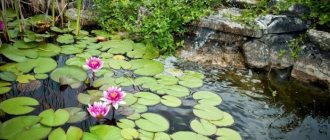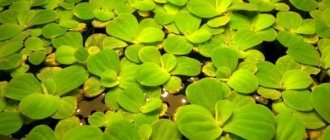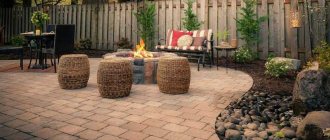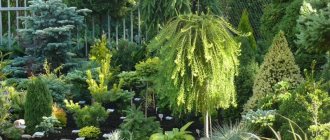Rock gardens are not as bright as mixborders, ridges or alpine slides. It would be a stretch to call it a flower garden; the definitions of a stone garden or a flower garden with stones are more suitable for it. Upon closer acquaintance with it, it becomes clear why: first of all, attention in the rock garden is drawn to the randomly scattered or installed in a strict sequence of stone blocks and crushed stone bedding. And only after this the gaze switches to the minor details of the composition: grasses, shrubs, background content.
Rockery and rock garden: what is the difference
Alpine slide
It is a mistake to consider a rock garden to be a type of rock garden. This is an independent type of flower garden, the design of which has its own rules. Of course, both flower beds have a lot in common, but upon closer examination, one fundamental difference can be identified. The alpine slide imitates a mountain flowering meadow, so the plants on it are an obligatory detail. Stone placers do not dominate the composition; they serve to create a mountain landscape and are in harmony with the vegetation.
In a rock garden, on the contrary, attention is focused on the stone. Vegetation is used as an auxiliary detail, complementing the overall picture. We can say that the plants in the rock garden are a kind of tool that helps emphasize the monumentality of inanimate nature.
Another important feature is the terrain. Usually a rock garden is created in the form of a hill (hill), which is decorated with brightly flowering unpretentious plants. That is why the name “alpine slide” is used as an equivalent to a rock garden. The classic version of the rock garden, on the contrary, is arranged on a flat, open area, where the space between the stones is filled with bedding. Plants are planted pointwise, without dominating the overall picture.
Names and photos of conifers for an alpine hill
A great variety of conifers have been bred for rockeries, and they all differ in shape, size and color. Among the wide range of species and varieties, it is not difficult to select specimens that meet the most delicate design taste.
Spruce
Spruce is a favorite of landscape designers for its low maintenance and high frost resistance. In addition, numerous varieties of spruce have needles of various shades: green, gray, and even golden yellow.
The photo shows the most popular representative of this conifer - the common spruce:
Various columnar varieties of gray spruce are very beautiful, but the scorching sun often burns the needles of these delicate plants, so they need to be shaded in the summer.
Cypress
Cypress is another very common conifer in the field of landscape design. The pea variety of the plant is considered the most frost-resistant.
The Filiferai cypress has an unusual appearance. It has long flowing branches that evoke a waterfall.
The Plumosa cypress has a spreading crown, but some varieties are quite compact and look good in small rockeries.
Juniper
To arrange rockeries, it is recommended to choose dwarf varieties of this fragrant conifer, which have a dense crown and are characterized by slow growth. Thus, European juniper will serve as an excellent decorative element for the background.
Horizontal juniper will be an excellent option for a coniferous plant for an alpine slide if you need to fill the space between the stones.
Fir
Fir trees for rockeries also have dwarf varieties.
Balsam fir has the most suitable crown density for rockeries.
Korean fir is frost-resistant, but it must be protected from direct sunlight.
Pine
Such a well-known conifer as pine is also valuable for landscape designers. This is especially true for plants with a spherical or spread-out crown, such as some varieties of Scots pine.
Often, when arranging alpine hills, varieties of low-growing pine are planted from coniferous trees.
Thuja
Thuja occidentalis captivates with its hardiness and appearance, but it requires sufficient watering, as it does not do well in dry soil.
There are also many varieties of coniferous plants that amaze the imagination with their color palette and shapes. But no matter what the choice of conifers is based on, they must certainly be combined with each other and create the appearance of an indivisible landscape.
What types of rockeries are there?
Despite the fact that vegetation in the rock garden is given a secondary place, it is it that determines the style of the composition. Depending on what plants are used in the design of the flower garden and their quantity, rockeries are divided into three main groups.
Types of rockeries:
- European;
- Japanese;
- English.
The European style implies that the landscaping of rockeries will use ground cover herbaceous perennials, characterized by abundant flowering. These include obrietta, arabis, tenacious. Low-growing annuals are also planted: purslane, coastal cineraria, lobelia.
Japanese style is an abundance of stones and sparse vegetation. Only in some places and very carefully are bright plants included in the plot. Mostly unpretentious grasses and grains are used: blue fescue, golden beard, acuminate reed grass, and reed molinia.
The English style is characterized by coniferous plants. As a rule, these are dwarf spruce and pines, low-growing and creeping junipers, and other low-growing conifer species. Plants with curved trunks and branches growing wild in the mountains are welcome.
Choosing deciduous
Among the wide range of plants in garden centers and nurseries, there are many tree and shrub species worthy of taking a place on the hill or at its base. In this case, size always matters, because the scale of slides on sites is usually small.
When choosing trees to decorate a rock garden, you need to imagine the growth prospects of a particular species or variety in order to avoid possible problems with the growth of the crown and root system.
Among deciduous trees, the choice is often made on low-growing willows , planting umbrella-shaped or horizontal forms grafted onto trunks, for example goat willow 'Kilmarnock' , whole-leaved willow 'Pendula' , purple willow 'Pendula' or other species (hairy willow, Far Eastern willow, Swiss willow) .
Globular forms, such as purple willow 'Nana' , are in high demand, as well as creeping willows pressed to the ground: creeping willow, reticulated willow, rosemary willow, polar willow . Other miniature woody plants with a compact, prostrate or weeping crown are also suitable for hills, for example, caragana tree 'Pendula', 'Walker' or 'Lorbergii' with thin lanceolate leaves, dwarf birch , mountain ash 'Pendula', small elm 'Jacqueline Hillier' ' with lacy branching and tiny leaves.
In larger rockeries, it is quite possible to plant silver birch of 'Youngii' form , cysten plum up to one and a half to two meters high with purple leaves, and squat plum with grayish foliage and a crown shape corresponding to the name. The garden landscape is enlivened and decorated with spring blossoms by the forms of the hybrid apple tree , which in many respects replace our traditional eastern cherry blossoms. Low crowns are formed, for example, by the varieties 'Tina' with white-pink flowers, 'Royal Beauty' and 'Cheal's Weeping' with red corollas on drooping shoots, 'Royalty' with crimson leaves and flowers.
Decorative varieties of apple trees with a weeping crown at the base of the hills and at the retaining walls
Rockery stones
Since the main thing in a rock garden is stones, it’s worth starting with them. One of the important conditions is their homogeneity. If in a rock garden some boulders that are not very suitable in style or texture can be disguised with plants, then in the case of a rock garden this technique does not work. All elements in it, even those in the background, are open and clearly visible. Therefore, one poorly chosen stone can disrupt the harmony of the composition.
The structure of the rock garden should be as close as possible to natural nature. Having chosen a certain storyline, you should adhere to it in all details: landscape, texture of stones, type of vegetation. For example, if the plot includes a pond, it is better to use pebbles and round boulders, as if polished by water.
And if the rockery imitates a rocky landscape, rough, angular blocks will look more natural.
Advice. In order not to make a mistake with the choice of stones, you should pay attention to how they look in natural conditions. To do this, you can visit the area that you want to copy, for example, a rocky river bank or a mountainous region.
Plants for rock gardens
Although the vegetation in a rock garden is not the main thing, its choice should also be taken responsibly. Even at the stage of planning and drawing up a diagram, you should decide in what place and what type of plant will be planted.
Five principles for selecting plants for rock gardens:
- Low growth rate;
- Non-dominant garden forms;
- The flower garden is not overcrowded with a variety of shapes, on an area of 10 square meters. it is enough to use no more than 12 types;
- Similar requirements for growth conditions;
- The degree of shading of the area is taken into account.
As a rule, vegetation adapted to mountain and desert areas is planted in a stone garden. They take root more easily among rocks and do not discord with the mountain landscape. These include decorative onions, sedum, cinquefoil, fescue, awl-shaped phlox, and parsley.
Features of care
Composition in pink tones
Caring for a stone garden depends on the composition of the planted species and the arrangement of the rock garden. But there are also universal recommendations:
- Watering is carried out as needed to a depth of 7-8 cm
- rockeries should be weeded, carefully removing weeds; the soil under the plants should be mulched to retain moisture after watering
- Fertilizers are applied only to those plants that need it
- regularly remove dead and dried leaves and inflorescences, and trim overgrown shoots of ground cover species
- new plants are planted in place of dead plants
- check whether the soil has been washed away during rains and snow melting; if this happens, add soil, sand and compact it
Near plants that require neutral or alkaline soil (gypsophila, edelweiss, parsley, lumbago), lime is added to the soil. Caring for rock gardens is not difficult and can be done by a novice gardener. If you follow the basic rules, a stone garden will delight its owner for many years.
VIDEO: Creating a rock garden in a couple of hours. landscape design
Creating a rock garden in a couple of hours. landscape design
Do-it-yourself rock garden in the country - the kingdom of stones and plants: step-by-step instructions + diagrams | (150+ Photos & Videos)
How to make a rockery yourself
Landscape designers are often invited to create a rock garden. They give advice on choosing a location and style of the flower garden, draw up a plan for the rock garden and carry out the technical part of the work. The owner of the site can only pay for the work done. But there is another way: to do everything yourself. This approach has two advantages. Firstly, you can immerse yourself in a creative activity and enjoy it, and secondly, the money will remain in your own wallet.
Selecting a location
A stone garden should not be hidden in the depths of the garden, where even the owners of the house rarely look. It is better to place it in plain sight, ideally on a flat area near the house or recreation area.
A suitable location is the area along the garden path leading from the house to the gate, gazebo or other frequently visited points on the site. The main thing is that the track is not secondary.
If you decide to set up a rockery in a small yard, you can allocate the most illuminated area near the fence for it. But in this case, the fence must be finished accordingly: like brick, wild stone.
Advice. An ordinary fence made of corrugated sheets will spoil the entire impression of a rock garden, so it can be decorated with coniferous plants. Densely leafy vines, for example, campsis and clematis, are also suitable for this purpose.
Planning
Creating a stone flower garden is not a matter of one day. You should prepare to bring your idea to life, and the best way to do this is to draw up a rough sketch. When the initial plan appears on a piece of paper, it is recommended to put it aside, and after a while return to it again and make amendments. Also, corrections are made as soon as a fresh idea appears.
It is easier to make a schematic drawing when you know the number of stones and their dimensions. Each stone is numbered, and its location is shown on the plan under the corresponding number. Thanks to this approach, during the construction of the rock garden there will be no confusion with the placement of stone parts. The most beautiful and valuable boulders are given a central part in the composition: they will form the basis of the flower. All others are distributed around the perimeter of the site. In the case when the rockery consists of 2-3 boulders, they are installed at a short distance from one another.
Advice. The tallest stones in the diagram occupy space in the background or on the sides. This way they will not obscure small details. In the case where the rock garden is planned on an open area, visible from all sides, the largest blocks are installed in the center of the composition.
Site preparation
It is best to prepare the site in the second half of summer or early autumn. At this time, the soil is most compacted, and it will be easier to compact it. Tamping is carried out with a round timber with a handle nailed to the upper end. The places where the largest stones will be installed are especially carefully compacted.
The grass is weeded out before compacting only when the site is too overgrown with perennial weeds. If the area previously had a lawn or is only slightly clogged, there is little point in cleaning it.
The resulting depression after soil compaction is filled with sand or gravel, and, if necessary, covered with agrofibre.
A thin (1-2 cm) layer of sand is poured on top of the textile. It is needed so that the crushed stone backfill does not damage the fabric.
Installation of stones
First, large blocks are installed. Round boulders are moved manually by rolling, and heavy stones of irregular shape are pulled using a winch, of course, if there is a suitable support: a tree, a pole. As a last resort, you can hire a bagger or forklift for transportation. After installing the stones, their stability must be checked and, if necessary, supports made of small cobblestones are placed.
Further smaller parts are distributed throughout the territory. They take their places according to the diagram. But it should be taken into account that in reality the composition may look slightly different than what was originally intended, so amendments are made during the work.
Lastly, the site is filled with crushed stone. It is desirable that it differ in color from the stones, and they stand out against the background of the bedding.
In places where plants are planted, the layer of crushed stone is minimal or not added at all. This will make it easier to plant them later.
Heather palette
Lovers of rockeries should not forget about the numerous representatives of the heather family, which can significantly enrich the floristic composition of the garden and its decorative effect. In places with acidic soils, low deciduous and evergreen rhododendrons , such as Kamchatka rhododendron , golden rhododendron with yellow , Canadian rhododendron with lilac inflorescences, blushing rhododendron with violet-blue flowers and many other species, as well as low-growing hybrid varieties .
In addition, in the spring the hill will be decorated with bright spots of flowering Erica (ruddy Erica and cross-leaved Erica) , and in the fall - heathers of different varieties. Less commonly used in culture are Podbelum multifolia (Andromeda) , which forms lanceolate leathery leaves with a silvery waxy coating, and the pretty pink-blooming Kalmia angustifolia with white bell-shaped flowers, Cassiopeia and Wintergreen , similar to cranberries.
By the way, small berry bushes, such as large-fruited cranberries , blueberries and lingonberries , will not only add attractiveness to the hill, but will also delight you with delicious fruits.
Representatives of the heather family
The main mistakes when arranging rockeries
In the practice of creating rockeries, one often encounters miscalculations. They can be of a purely mechanical nature, as well as design ones. You can avoid such mistakes if you consider the following points.
Possible errors and ways to solve them:
- 2-3 years after laying the rock garden, the stones are completely hidden behind the vegetation. fast-growing shrubs and tall trees should not be planted in it All plants with a voluminous crown are placed outside the rock garden (no closer than 4-5 m);
- The soil is subsiding and large boulders are moving. The problem is solved at the stage of preparing the site: you need to compact the earth well, especially for the largest blocks. If the stone is unstable, smaller elements are placed under its base to create support;
- The flower garden is overgrown with weeds. Garden geotextiles prevent the germination of weeds. It is laid on a sand (gravel) bed, after which crushed stone filling is made. Plants are planted in slots made after spreading the canvas.
Advice. Since agrofibre is subject to significant mechanical action due to the weight of the stones, landscape designers recommend using water-bonded or needle-punched non-woven fabric, which is characterized by high strength and good water permeability.
Catchment (Columbine)
This exquisite herbaceous perennial exhibits unique blooms with long, narrow petals. The flowering plant comes in a variety of colors and attracts butterflies. Once established, this slender wildflower is drought tolerant. Cut it back in the fall and see if volunteer shoots appear in the spring.
How to care for rockery
Of the three components that make up a rock garden, stones require the least maintenance. In the spring, the rocky garden is inspected and, if displacement of boulders is noticed, they are corrected. You don’t need to do anything else with the stones, unless you want to change the composition by swapping them.
The filling should be updated occasionally. This is not done every year, but as needed, for example, when the soil has subsided. Crushed stone or pebbles are poured into the formed depressions. It is important that the new material is identical to the previous one in size, color and shape of the fractions. If it is not possible to find it, the new bedding is mixed with the old one, so that inclusions of fresh material are evenly distributed over the entire area of the site.
Vegetation care is carried out according to the same principle as in other types of flower beds and depends on the specific type of plant. Particular attention is paid to formative pruning of deciduous shrubs, since their crowns should not exceed the designated boundaries. If perennials with a rapidly growing root system are used in the garden, they should be fenced off with border tape, otherwise after 3-4 years the rock garden will look more like a rock garden.
Border tape
Video on creating a rock garden:
dizlandshafta
Setting the stage
For most vegetation, a mixture of turf soil, leaf soil, sand and peat is suitable. If the rock garden is located on a hill, artificial or natural, you need to give it time to settle for a couple of months. After some time has passed, add fresh soil and you can plant.
Plants are planted in a certain order, first woody conifers, then deciduous shrubs, and then creeping ground covers.
Advice! You should not add nutritional supplements to the soil, as this will lead to rapid plant growth.











